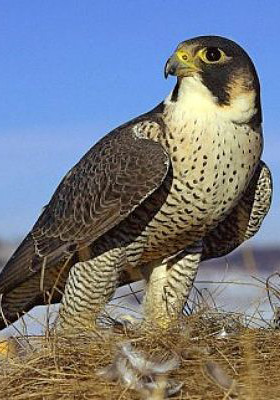Falcon (Falco Peregrinus)

| Order: | Accipitriformes |
| Family: | Falconidae |
| Subfamily: | Hierofalco |
| Genus: | Falco |
STATUS:
ATTENTION! THIS ANIMAL IS LISTED AS ENDANGERED IN THE REPUBLIC OF UZBEKISTAN! 2(VU:R): Vulnerable, rare species. Listed on the IUCN list as (VU), introduced to CITES appendix II.

In the Republic of Uzbekistan special attention is paid to the protection of birds of prey, listed in the Red Book. It is a criminal act to illegally produce, possess, purchase, transport or smuggle a Peregrine falcon.
This is a bird of prey from the falcon family about the same size as a grey crow, much larger than Kestrels and the smaller and sleeker Saker. Its plumage is a dark, slate-grey on the back, with a light belly and a black top of head and black ‘moustache’. There are about 17 subspecies of Falcons, discernible by their different markings. The Falcon is the fastest bird in the world. In a swift dive, it is able to reach speeds of over 322 km/h or 90 m/s. In horizontal flight the Falcon is inferior in speed only to the swift.
In Uzbekistan, the Falcon is a very scarce wintering bird, characteristic to lowland areas. The first autumn birds appear in Uzbekistan in late October. Due to the general decline in the last decades of the species on Uzbek territory, the Falcon is much rarer than in the last century.
The Falcon is cosmopolitan, common on all continents excepting Antarctica. Being extremely adaptable to its environment, it easily survives in the cold climate of the Arctic tundra, reaching 70° North latitude in Greenland and 78° North latitude, the ‘New Earth’ archipelago, as well as in the hot tropics of Africa and South-East Asia. In General, at different times of the year the Falcon can be seen almost everywhere, except in polar and high mountain areas, deserts and most of the tropical rain forests.
The main prey of the Falcon are game species such as; blue-grey doves, starlings, ducks and other aquatic and wetland species, which they were hunt almost exclusively in the air, taking advantage of their own speed. While hunting, the Falcon sits on its perch or searches for game in the sky, before rising over its prey, almost at a right angle quickly swooping down, hitting its target with folded wings and talons pressed close to the body. The strike from the talons is so strong that even the heads of big game will sometimes fall off. It is much rarer for Falcons to hunt small mammals.
Falcon nests on the rocky cliffs, the tops of ridges, bumps rarely on moss bogs or stone buildings - roofs and ledges of tall buildings. Sexual maturity comes at the age of two years, the couple saved over a lifetime. Eggs are laid once a year, in late April-early May. If the original brickwork for any reason is lost, the female can lay eggs again. Usually, the female lays three eggs (sometimes two to five), one every 48 hours. They are brightly coloured eggs; brownish or reddish, with a dark reddish-brown spots and speckled. Egg size 51-52 x 41-42mm. The incubation period is 33-35 days; hatching eggs may be both parents, but most of the time in the nest is the female. Hatched chicks are covered with dirty-white fluff, have disproportionately large feet and completely helpless in the first days of life. The female warms and feeds the chicks while the male produces food. Aft territory during the breeding season usually reaches 19-24 km in radius from the nest. The first flight of the chicks committed at the age of 35-45 days, but for a few more weeks remain dependent on their parents for as long as they learn self-produce their own food.
Since ancient times, the Falcon has been used for falconry. In the Middle Ages, falconry was extremely popular in many European countries, but always remained an activity exclusive to the upper classes. For example, in the English treatise ‘The book of Saint Albans’ (1486) it argues that only a prince or duke may possess a Falcon.
1. Red Book of the Republic of Uzbekistan: II is Animals, Tashkent: Chinor ENK, 2009. 2. Meklenburtsev RN, Sagitov AK Kashkarov DY, Mitropolsky OV ER Fotteler Tretyakov GP, Ostapenko MM Nazarov, AP Birds of Uzbekistan, including Tashkent 1. ‘Fan’ of the Uzbek SSR. 1987.
